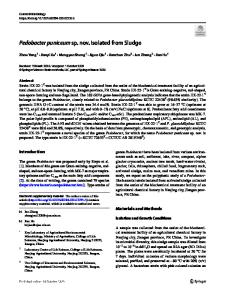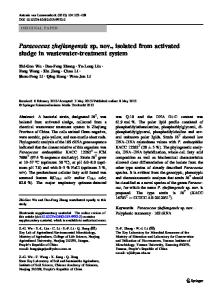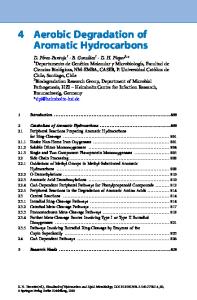Aerobic degradation of BTEX compounds by Streptomyces species isolated from activated sludge and agricultural soils
- PDF / 1,622,976 Bytes
- 12 Pages / 595.276 x 790.866 pts Page_size
- 61 Downloads / 302 Views
ORIGINAL PAPER
Aerobic degradation of BTEX compounds by Streptomyces species isolated from activated sludge and agricultural soils Amira Hocinat1 · Allaoueddine Boudemagh1 · Hocine Ali‑Khodja2 · Meissa Medjemadj1 Received: 14 January 2020 / Revised: 28 April 2020 / Accepted: 24 June 2020 © Springer-Verlag GmbH Germany, part of Springer Nature 2020
Abstract In this study, we tested the ability of Streptomyces to use for their growth benzene, toluene, ethylbenzene, and o-, m-, p-xylenes as sole source of carbon and energy. These bacteria were isolated from agricultural soils and activated sludge samples from a wastewater treatment plant. The results show that Streptomyces are capable of degrading at least one of the BTEX compounds. Among them, 3 isolates from activated sludge called (U, F and V) and a single isolate (SA13) isolated from an agricultural soil, can use as the sole source of carbon and energy, all of these BTEX compounds at concentrations of 1500 mg/L. Based on the analysis of the 16S rRNA gene sequence, two active strains were identified as Streptomyces fimicarius, Streptomyces cavourensis, Streptomyces flavogriseus and Streptomyces pratensis. These strains can be excellent candidates for the bioremediation of the telluric and aquatic sites polluted by these xenobiotics. Keywords BTEX · Streptomyces · Activated sludge · Agricultural soils
Introduction Benzene, toluene, ethyl-benzene and xylene are abbreviated as BTEX. These compounds are environmental pollutants which contaminate several ecosystems (Diaz 2004). In the air for example, BTEX are produced by varnishes, solvents, plastic, leather, lacquers, inks, etc. They can also form during the combustion of organic materials as Communicated by Erko Stackebrandt. Electronic supplementary material The online version of this article (https://doi.org/10.1007/s00203-020-01970-4) contains supplementary material, which is available to authorized users. * Hocine Ali‑Khodja [email protected] Amira Hocinat [email protected] Allaoueddine Boudemagh [email protected] 1
Faculté Des Sciences de La Nature Et de La Vie, Département de Microbiologie, Université Frères MentouriConstantine 1, 25017 Constantine, Algeria
Laboratoire de Pollution Et de Traitement Des Eaux, Faculté Des Sciences Exactes, Département de Chimie, Université Frères Mentouri-Constantine 1, Constantine, Algeria
2
is the case in forest fires, cigarette smoking or even burning a scented candle. But the main source of air contamination remains gasoline and various exhaust gases from engines (Diaz 2004; Yadav and Reddy 1993). In surface waters, BTEX are among the most abundant hydrocarbons (Neff et al. 2011). In groundwater, the main sources of BTEX are fuel spills and leaks in underground storage tanks. These xenobiotics also contaminate other ecosystems such as soils and other natural environments (Pinedo et al. 2013). BTEX are very dangerous for health as they are carcinogenic, neurotoxic and genotoxic (Masekameni 2019). The US Environmental Protection Agency
Data Loading...











